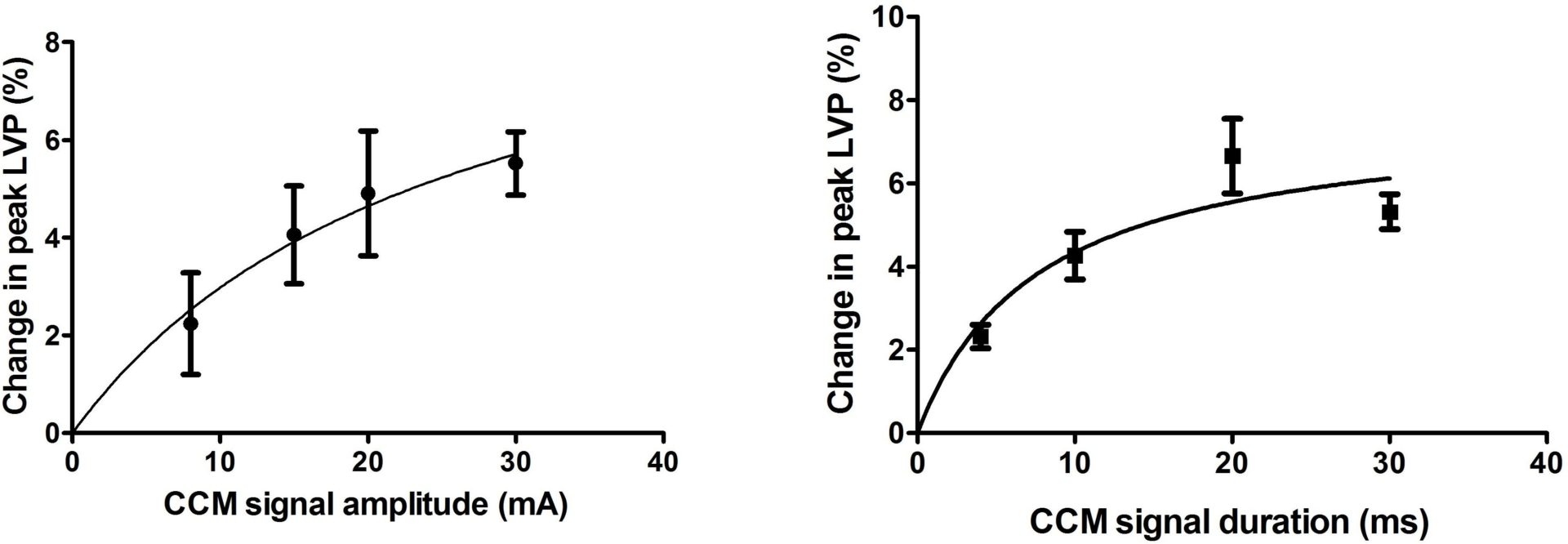Application of electrical currents to the ventricle during the absolute refractory period promotes contractile force production. To date studies into the mechanism of action of this cardiac contractile modulation (CCM) therapy have been inconclusive. Previous reports in isolated papillary muscles and whole heart preparations have suggested that CCM therapy involves enhanced intracellular calcium transients and a prolongation of action potential duration [1, 2]. The primary aim of this study was to elucidate the mechanisms of CCM induced inotropy and to study its effects on action potentials in the isolated beating heart. Experiments were carried out in isolated New Zealand white rabbit hearts under conditions of constant flow. Ventricular pressure was measured iso-volumetrically with a fluid filled balloon. Bi-phasic square wave pulses were applied to the left ventricle using hook electrodes and timed to coincide with the absolute refractory period as measured from local mono-phasic action potentials. Local action potential duration (APD) was calculated (average of 20 beats) both before CCM and immediately after the cessation of stimulation. CCM mediated responses were assessed at under various conditions (range of signal amplitudes, signal durations and locations of signal delivery) and during perfusion with the β1 adrenoceptor antagonist metropolol. Statistical comparisons were made using paired Student’s t-tests. Data represent mean ± SEM. Contractile responses to CCM varied with both the signal amplitude and duration of stimulus in a curvilinear manner (Fig 1, n=5). CCM resulted in a shortening of APD which was linearly related to the signal amplitude and curvilinear to signal duration (Fig 2, n=5). Preliminary evidence suggests that the location of stimulus application may influence the inotropic response during CCM (% increase in left ventricular pressure (LVP): Apex 1.05 ± 1.21 vs. Base 7.33 ± 1.77, p<0.05 n=5). Both the inotropic effects (% increase in LVP; 5.67 ± 1.5 vs. 0.65 ± 0.89, p<0.01 n=6) and shortening of APD (% decrease in APD: -14.6 ± 3.36 vs. 0.1 ± 1.08, p<0.05 n=6) seen during CCM were abolished during perfusion with metropolol. These data demonstrate that CCM inotropy is mediated via β1 adrenergic receptor signalling in the isolated rabbit heart. Contrary to previous reports CCM was associated with a shortening of ventricular APD in keeping with the well documented effects of β1 adrenoceptor activation. It seems likely that CCM induces catecholamine release from sympathetic nerve fibres within the ventricle and that the variations in response with location represent the relative innervation of these regions.
University of Manchester (2010) Proc Physiol Soc 19, PC209
Poster Communications: Inotropic enhancement during cardiac contractile modulation is associated with a shortening of epicardial action potential duration and is prevented through pharmacological ??1 adrenoceptor blockade in the isolated rabbit heart.
J. Winter1, K. Brack1, A. Ng1
1. Cardiovascular Sciences, University of Leicester, Leicester, United Kingdom.
View other abstracts by:
Figure 1.
Figure 2.
Where applicable, experiments conform with Society ethical requirements.


